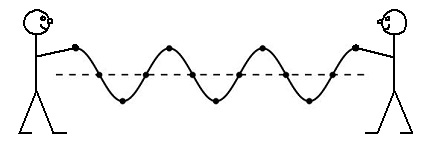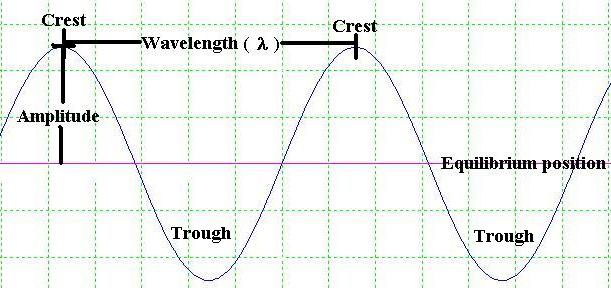
A Shive Wave Machine is shown above.
A wave is a disturbance that travels through space and time by the transfer of energy without the transfer of matter. When a moving wave consists of oscillations occurring perpendicularly to the direction of energy transfer, it is called a Transverse Wave
An example of transverse wave is when we created a wave in a rope by stretching it and moving one end back and forth again and again. Electromagnetic waves, such as the light, are also examples of transverse waves
In this exhibit, each stick moves up and down. The energy is transferred to the neighbors through the twisting of the central wire, which cause a cascade of oscillations between neighboring sticks.

Waves can be described by a number of variables, included: amplitude, wavelength, period and frequency.
- The amplitude of a wave (A) is a measure of the magnitude of a disturbance in the medium during one wave cycle. In this exhibit, the amplitude of a wave will be the distance between the maximum displacement of the stick on the vertical direction and the equilibrium point (the point of zero displacement).
- The wavelength (λ) is the total distance traveled by the wave in one full cycle. In this case, the wavelength can be given by horizontal distance between repeating units of wave pattern.
- The period (T) is the amount of time it takes to complete one cycle.
- The frequency (f) is the number of cycles the wave completes in a given time, and is the inverse of the period.
f = 1/T, where T is given in seconds (s) and f in hertz (Hz).
The frequency and wavelength are related by the velocity of wave:
v = λ f, where λ is in meter (m) and f is in Hz.

To Do 1:
- Press the white bottom to start.
- Switch S1 down to Pulse mode.
- Adjust the knobs of Amplitude and Frequency the way you can see clearly a pulse of wave.
- Vary kindly the Amplitude and Frequency and notice the difference on the pulse shape.
To Do 2:
- Switch S1 down to Wave mode.
- Adjust the knobs of Amplitude and Frequency the way you can see clearly a wave propagated through the exhibit.
- Vary kindly the Amplitude and Frequency and notice the difference on the wave shape.
To Do 3:
- On the Wave mode, switch S2 up to turn on the Damp mode.
- Notice the difference on the wave shape.
- Make the same on the Pulse mode.